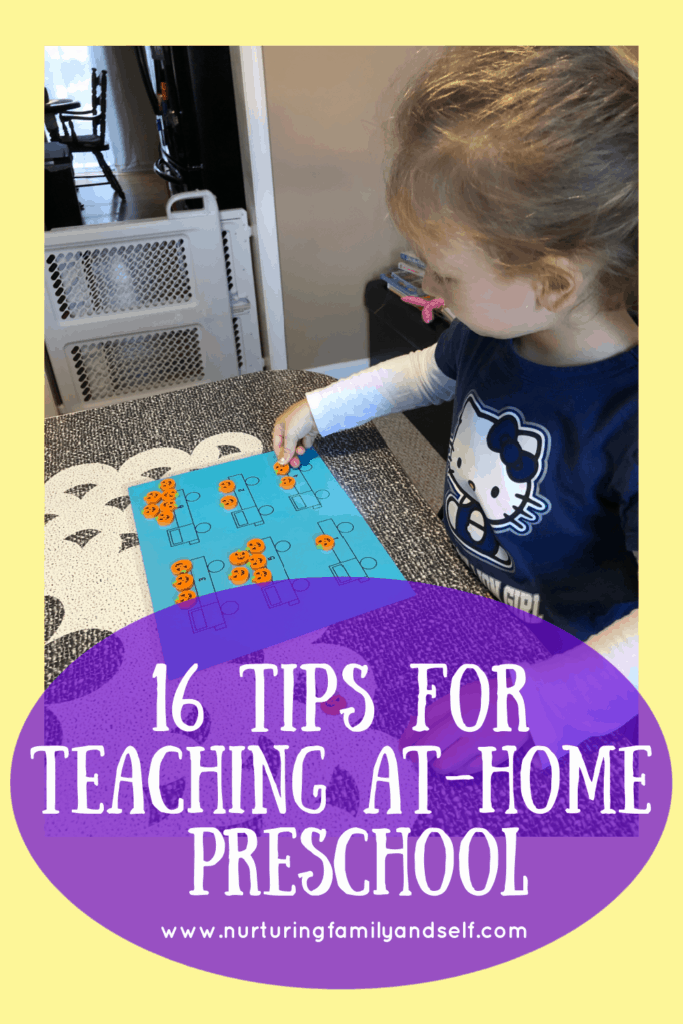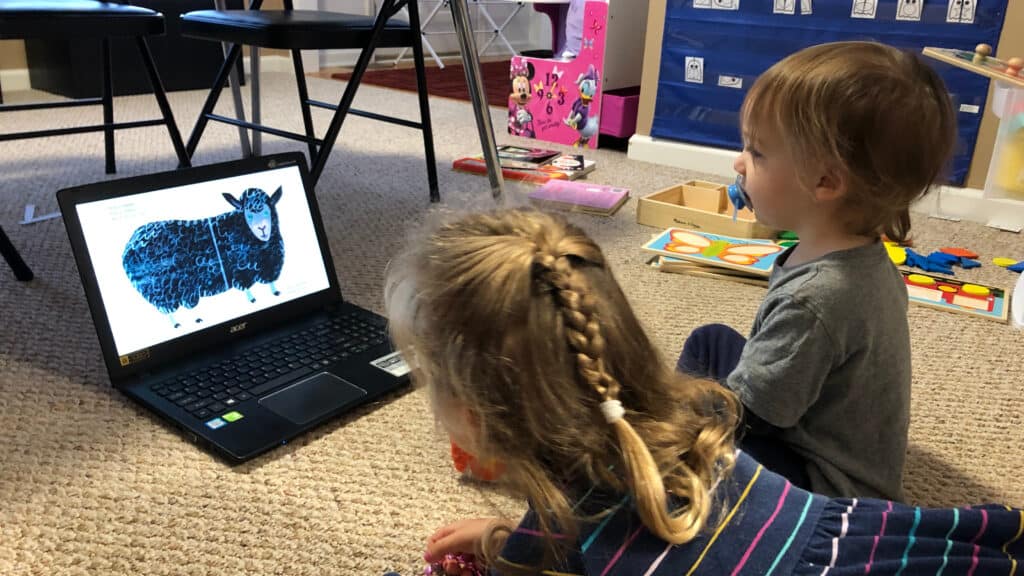This post may contain affiliate links. If you choose to make a purchase through these links, I earn a small commission at no cost to you. I do not promote anything I do not believe in or stand behind.
Teaching preschool at home to my almost 4 year old daughter is an experience filled with mixed emotions and lots of ups and downs. We have our good days and we have our bad days, which I expected. Our first two weeks focused on learning about apples followed by two weeks of learning about colors. As I planned for teaching preschool at home and prepared materials, I didn’t fully know how my daughter would respond or how quickly she would complete each activity. Needless to say, the first four weeks taught me a lot about my daughter and teaching her. I’m so thankful for the opportunity to teach her and learn alongside her, but it is definitely met with some challenges.
In this post, I’m going to share with you the four challenges I’ve found that come with teaching at-home preschool. Then, I will share 16 ways I overcame these challenges. These 16 tips are based on the things I learned while teaching my daughter during our first few weeks of preschool.
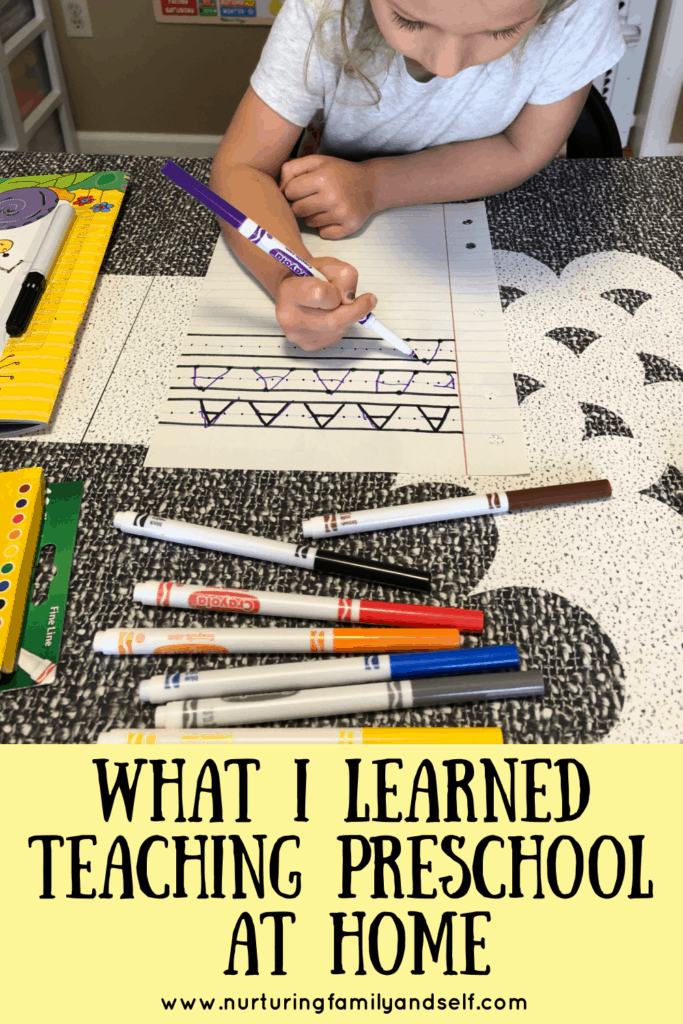
What are the challenges that come with teaching preschool at home?
The first challenge is fitting in at-home preschool into our day while continuing to do all of the home management things, meal planning/cooking, laundry, and house chores. As a stay-at-home mom, the to-do list is never ending, along with the piles of dirty clothes (and the baskets of folded clean clothes) and demands of my kiddos. These things still need to get done and now I’m adding preschool lesson planning to my very full plate. Last year, when my daughter attended preschool, I used the 2 1/2 hours to run errands, catch up on house chores, and/or work on blog projects. Basically things that were easier to do without an energetic 3 year old running around. My son, who was less than a year at the time, typically took his morning nap while my daughter was in preschool.
The second challenge is keeping my 1 1/2 year old toddler occupied so I can focus on teaching my daughter. He wants to be part of the action. I struggle with this because I want to make sure I can focus on my daughter and give her my full attention, but at the same time, I’m still dividing my attention between the two. My daughter doesn’t respond well to shared attention. She doesn’t like when her brother is touching something she’s using/playing with or is in her space. She experiences some very strong emotions so helping her manage these at the same time adds to this challenge.
The third challenge is the stress that comes with making sure I am effectively meeting the learning needs of my daughter, building on her strengths and current skill level. My daughter is smart and picks up vocabulary very fast. I want to make sure I am engaging her in lessons and activities that build her knowledge and skills. I also want to make sure I am working on those skills with which she needs more practice. She is strong-willed and extremely stubborn at times so this impacts our preschool time. Using her strengths and interests to improve her weaknesses is challenging. I don’t want to fill our day with worksheets and screen-time. Rather I want to utilize a variety of hands-on and play-based activities, which require time and energy to plan. I don’t want to spend a fortune on a preschool curriculum and materials.
The fourth and final challenge is giving her plenty of opportunities for socialization, which is the one thing she is missing out on not being in a public preschool setting. Due to the current pandemic, COVID-19, we are under limitations as far as public places go. But, I still want to provide my daughter with opportunities to play with others her own age and build her social skills that are so important for future success. She needs interaction with other children outside of mommy, daddy and baby brother.
How do I overcome the challenges of teaching preschool at home?
Over the past four weeks, I learned some ways to overcome the challenges of teaching preschool at home. I want to share these with you in hopes of helping you with your own experience of teaching your preschoolers at home. We all need to support each other as we navigate this new world of at-home learning.
Dedicate time for planning preschool.
Planning out our preschool activities, and just our week in general, helps eliminate the mind clutter and also sets us up for success throughout the week. However, taking the time to plan can be challenging when there are a million other things that need to get done. I’ve found that setting aside a block of time to plan for the upcoming week makes the days and weeks run smoother.
Sundays are used for planning. Usually while watching the Philadelphia Eagles play football, I’m hanging out on the couch planning away. Our daughter spends Sundays at her grandparents’ house and my son is usually napping for a chunk of the afternoon. We typically don’t have any plans on Sundays and utilize this day for getting ready for the week. Plus, my husband enjoys some playtime with my son (when he is awake), which leaves me with more time to plan and prepare for the upcoming week. So Sundays are the ideal day for me to schedule in preschool planning time.
Think about your week and pick a day or chunk of time to dedicate as planning time for preschool. Write “Preschool Planning” in your planner or calendar as a weekly event. Or schedule several smaller chunks of time throughout the week. I personally like to do all my planning in one block of time, but you need to do what works best for you and your family.
Keep your planning simple! Use your favorite planner, a spiral notebook, a planning app on your phone or simply write into your phone calendar. I personally like using a spiral notebook. There is plenty of space for me to write down the activities I plan to do with my daughter. I’ve also started using a table I created in PowerPoint to record all of the ideas for each area of learning we do during preschool.
Set weekly goals and identify daily tasks for preschool.
We all know that having goals in mind keeps us focused and gives us direction. Each week, we focus on one specific preschool theme and a letter. All the books we read and learning activities we do center around this one specific theme. We are using Playing Preschool Year 1 from Busy Toddler as the basis for our at-home preschool learning. This preschool curriculum is inexpensive, costing $39.90 for 190 days (38 weeks) of hands-on, play-based learning. That’s only 21 cents a day or $1.05 per week!!
I look at the plan for each day, write down the book we will read and choose the activities I want to do with my daughter. Then, write these down in my spiral notebook next to each day. Some days I choose to add a few more learning tasks, but use the Playing Preschool outline as a starting place. My goal each day is to incorporate a reading comprehension and phonics (working with letters/words) task, math task, and outside/gross motor activity.
Designate a space where preschool will happen in your home.
I think it is important to designate a space in your home where learning will take place. We are lucky enough to have a room that can be used as our at-home learning space, but the consistency is what is most important. The kitchen table, a specific spot on the carpet in the living room, or a kid’s table in the playroom are all wonderful places to teach and learn with your child. Don’t stress about the actual space in your home. Just pick a spot and start. Sometimes our learning takes place in other areas of our home, too! We start out in the activity room and then move to the playroom or go outside.
Set up a consistent preschool routine for your child.
We all know that children, especially babies, toddlers and preschoolers crave routine. Even moms crave routine!
We try to follow a consistent preschool routine in our home. Preschool takes place after breakfast. Here is our daily preschool routine:
- Calendar
- Theme Songs
- Read Book
- Reading/Literacy Activity
- Math Activity
- Outside/Movement
- Snack
- Lunch
- Craft/Art Project/Special Activity
My goal every day is to incorporate a literacy activity and math activity that is connected to the book/theme we are studying. This makes our learning fun and meaningful. I purchased Playing Preschool from Busy Toddler and use the daily lessons as a guide, adjusting along the way to meet the learning needs of my preschooler.
Be flexible.
Our preschool routine isn’t perfect every day. Some days it gets interrupted and some days we don’t even do preschool. And, you know what? That’s ok!
Some days we spend more time outside with friends at a playground. Some days we spend time visiting with family. Some days my preschooler is really into preschool and some days it’s a struggle to get through our daily learning activities. The one benefit to at-home learning is that you can be flexible and follow your child’s lead.
Teach preschool with a buddy.
Preschool is also about giving your child practice with his/her social skills. However, the one downside to at-home preschool is the limited socialization your child will get. Therefore, find a buddy (or 2) who is doing at-home preschool, too! Each week, plan to get together to do preschool. Meet over Zoom, Google Hangouts or FaceTime. Technology makes it possible to see other people and have face-to-face conversations, especially in today’s current state of things.
Find those other mommas who are teaching at-home preschool to their littles. Plan lessons, activities and learning games together. Share ideas with one another. Create boards on Pinterest that you share with one another so all your ideas get saved in one place.
Choose a theme for 1-2 weeks at a time.
One feature I love about Playing Preschool is the themed learning. There are 19 units with each unit (or theme) lasting two weeks. I believe this style of thematic learning is so important for our little ones. Teaching a theme helps children see connections among the content being studied and deepens their vocabulary knowledge as they hear similar words used many times. I also think it is fun to bring out special themed books, activities and learning materials every two weeks. I’ve found that two weeks is just the right amount of time for each theme. Longer than two weeks, my preschooler and I start to get bored and tired of talking about the same topic.
Incorporate preschool learning into all parts of your day.
One thing I’ve learned A LOT since starting Playing Preschool with my daughter, and just at-home learning in general, is there are so many ways to incorporate letters, math and preschool learning into the daily things you already do.
While your child helps you fold the laundry, count and sort different items of clothing. Talk about the different fabric textures, sizes, patterns, and colors on the clothing.
Bake something together. Talk about measuring the ingredients. Have your child count as he/she adds ingredients. Mixing, pouring, scooping and transferring ingredients while baking is the perfect learning and sensory experience.
Take a walk around the neighborhood and look for specific things. This is probably my favorite way to incorporate preschool learning into our day!! We all get some fresh air and exercise and do some learning at the same time. What could be better!?
Focus on the letter of the week, specific colors or shapes. Collect, count and compare the things you find while out on a walk. I’m writing this post when it is fall so we have collected acorns, leaves of different colors and shapes, sticks and pinecones on our walks. We talk about them when we get home, sort them into categories and count how many of each category we found. Even my toddler got involved in collecting things while on our walks!
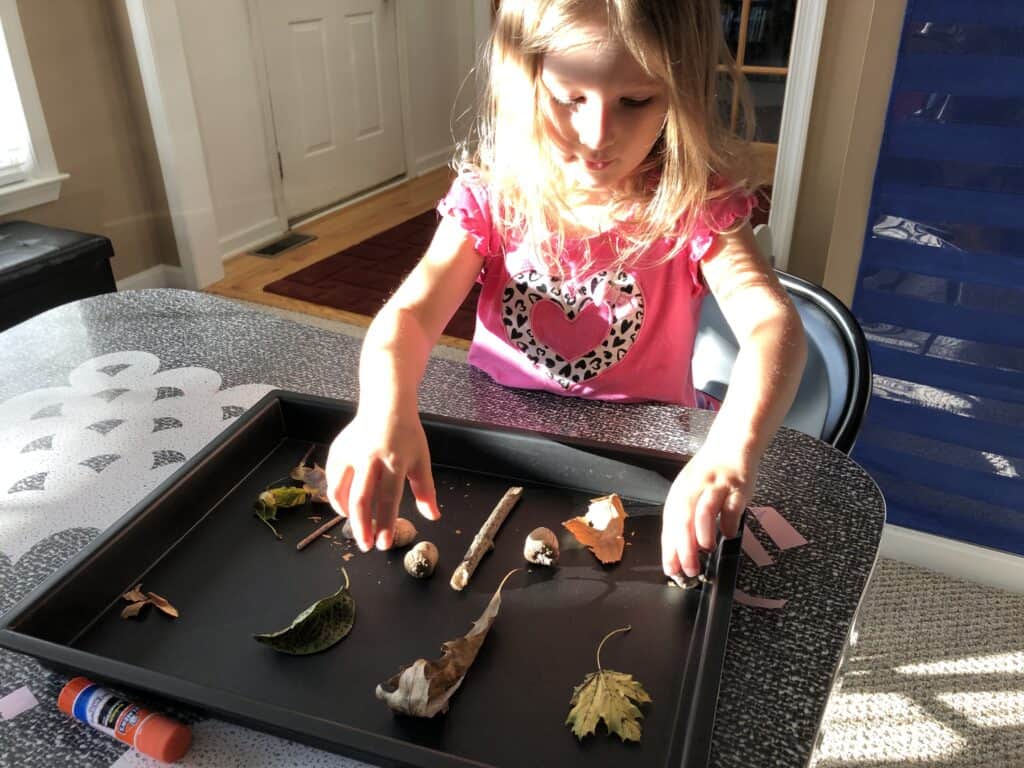
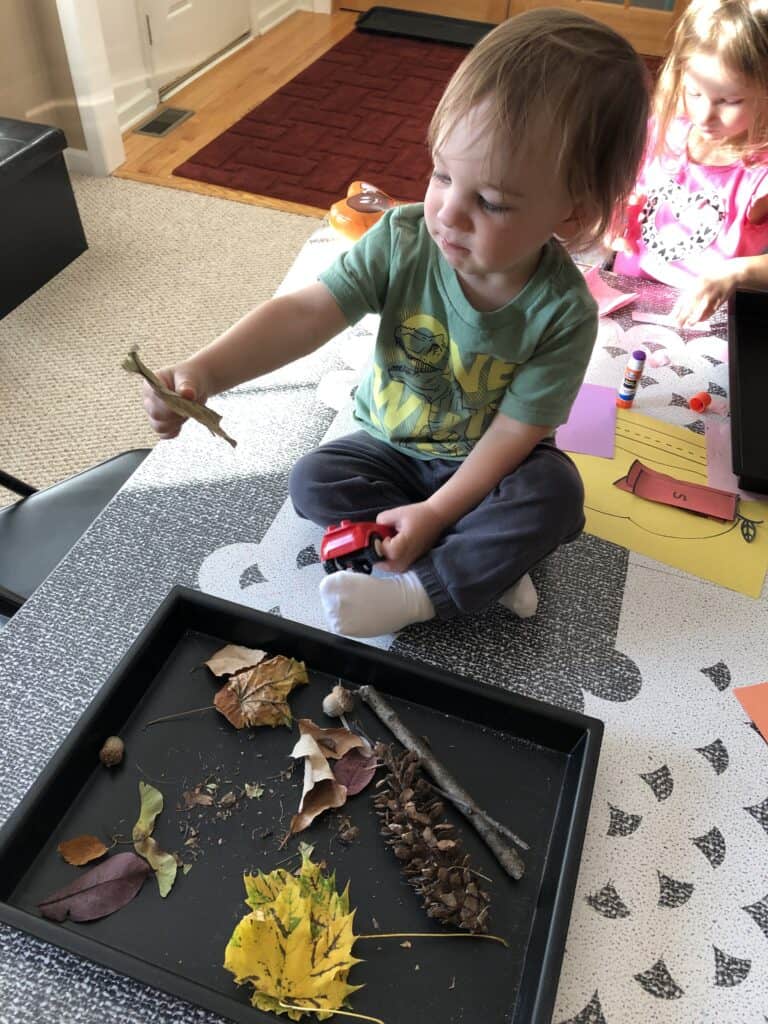
Prepare meals that relate to the preschool theme. The first two weeks of preschool at home was all about apples. We made baked oatmeal, Apple Cinnamon Cheerios Bars, Apple Jacks Marshmallow Treats, Chicken Apple Sausage with Veggies & Potatoes Sheet Pan Dinner, and ate applesauce. Yum!
During our second unit, colors, we wore clothes that matched the color of the day, ate colored Goldfish for snack and ate a rainbow of produce at each meal.
Learning really is all around us and it has become so much fun finding ways to incorporate it into what we are already doing during the day: getting outside, taking walks, getting dressed, eating meals, snack time and playtime.
Don’t be afraid to utilize screens for preschool.
It’s okay to incorporate screen time into your preschool routine. There are many great YouTube, Neflix and Amazon Prime Video shows perfect for extending the at-home learning. In fact, I actually found some of the books we needed for the colors unit being read on YouTube. We didn’t own the book for the lesson, nor did our library have it. One of the books we read for purple day was “Harold and the Purple Crayon”. Well, Prime Video actually has this story as a short episode. Did you know there are lots of other books on there, too?? It’s pretty neat and a wonderful way for our little ones to enjoy stories!
We discovered the YouTube channel Monica J. Sutton who does a series called “Circle Time with Ms. Monica”. It is so cute and perfect for my preschooler and toddler to enjoy during snack time or while we are transitioning from breakfast to preschool. It gives me 20-30 minutes to clean up from breakfast. Ms. Monica squeezes so much learning into her Circle Time episodes and we love watching it! She sings songs, asks questions, talks about a letter and shape for the week, incorporates counting, colors and dressing for the weather. Each day of the week is a different theme: Welcome Monday, Math Tuesday, Craft Wednesday, Dance Party Thursday and Writing Friday. I highly recommend it!
I know there are a lot of great educational and learning apps for preschoolers out there. We haven’t ventured into any of them yet, but several of our friends use them! These are great for supplementing the at-home preschool learning you are doing, too! Your preschooler practices reading and math in an engaging and fun way for him/her.
Don’t spend too much time searching for ideas on Pinterest.
Pinterest is a wonderful search engine, but it can quickly become overwhelming. Therefore, I would suggest using Pinterest with a specific goal in mind and not spending too much time searching for ideas. Set a timer and when the timer goes off, stop searching.
Use the materials, books, toys and other items you already have in your home for learning activities.
Any items in your home can be sorted or counted. Cardboard boxes make great surfaces for drawing shapes, painting letters and numbers. Use your child’s toys to sort by color. Go on an alphabet hunt and find a specific letter in books or find items that start with that letter. Don’t feel the need to go out and buy all of these learning materials. Start with what you already have in your home, especially your kitchen pantry and toy box, and go from there. Also, the library is your best friend when it comes to extending the books you and your child are reading together.
When all else fails, read a book or go outside.
Reading books is one of the best things you can do with your preschooler. Books guide conversation and inspire play. Reading books daily to your child is the #1 way to expose him/her to a variety of language patterns and vocabulary. A stronger vocabulary leads to future academic success. Plus, reading books is the one activity that can be done with all ages. It brings you closer to your children and creates lasting memories.
The fresh air is good for everyone. Going outside gives your child and you a much needed change of scenery. Whether we take a walk around the neighborhood, draw with sidewalk chalk, go for a bike ride or visit the playground, getting my preschooler and toddler outside is a top priority of mine!
Give yourself some grace.
Just remember that you are doing the best you can for your children. Give yourself some grace and don’t expect perfection. Every day is going to bring its own challenges. So be kind to yourself and let things go if you need to. Don’t be too hard on yourself if your preschooler isn’t interested in doing a specific activity. Try something new or just take a break. Come back to your preschool lesson later in the day.
Let your child guide your lessons/activities.
Take note of what your child is interested in at the time. My daughter pulled out this giant ABC floor puzzle to do the other day. She loves puzzles! So I took the opportunity to review the letters and letter sounds with her. The second time we put the puzzle together, I spread the pieces all over the room so she had to move around and find a specific letter. She enjoyed it!
However, we have days when my daughter is not interested or engaged in the activity I planned. What I’ve realized is that it is okay to come back to it later or scrap it altogether. There were a few times when I was able to come back to an activity when my toddler was napping or daddy was finished working.
Preschoolers are unpredictable and most learning should happen through play anyway. So, if what you are doing is not fun for you and/or your child, try again later and engage in something they want to do.
It’s also important to try to figure out your child’s learning style. Every child learns best in a specific way. One of the many benefits of at-home preschool is having the freedom to cater lessons and activities to your child and how he/she learns best. If your child can sit, color, and glue without issue, that’s great! But if your child is a more active learner, you might want to incorporate movement and physical learning challenges into your day.
Incorporate your child’s interests into at-home preschool.
This is similar to the previous tip, but if your child is interested in dinosaurs, then incorporate counting dinosaur stickers into your at-home preschool. Read books about dinosaurs. Sort and count a set of dinosaur toys.
My daughter loves to create things by cutting paper, painting and drawing. So we do a lot of activities that involve cutting paper, painting letters and numbers and drawing pictures.
When your child’s interests enter the learning, he/she is more motivated to engage in the activity. This makes it more enjoyable for all of you!
Snacks make great manipulatives (and motivators 😉).
You can count snack items, trace letter shapes and numbers with them. This is wonderful for building fine motor strength, especially the pincer grasp. Depending on the snack item, you can sort them by color. My preschooler LOVES doing activities that involve special snack items. They also motivate her to complete an activity because she knows she gets to eat some at the end.
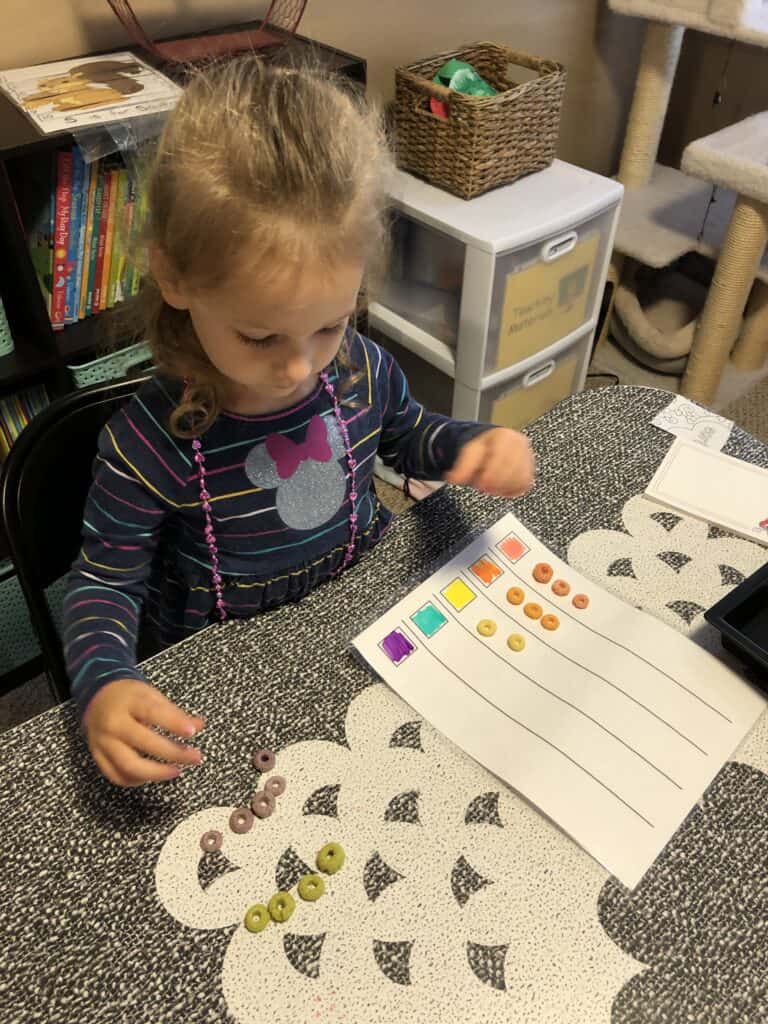
Conclusion
The teacher in me is excited to be teaching my daughter at home. While some days are met with challenges, I just love seeing her learn and we have so much fun incorporating preschool learning into our days! All of the tips I’ve shared in this post have been so helpful to me and I hope they are helpful to you, too. I want you to feel encouraged and inspired to teach your preschooler at home. It truly is a rewarding experience and something I will never regret doing. Be sure to share this post and the tips with anyone you know who is teaching at-home preschool to their child 😊
